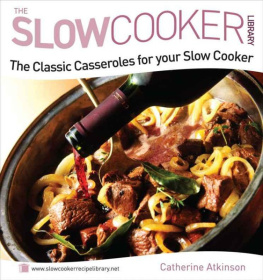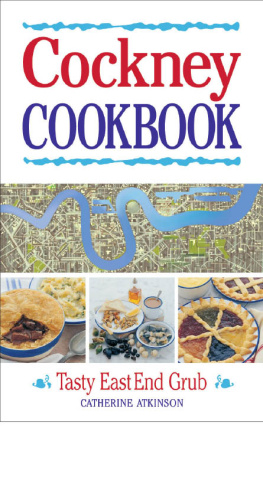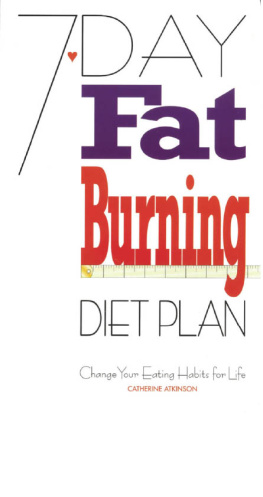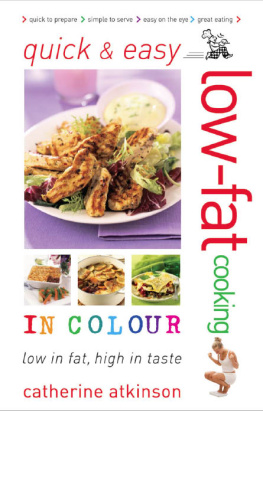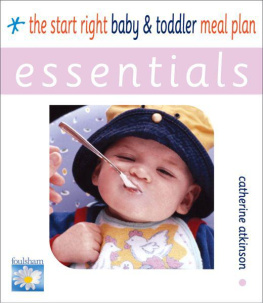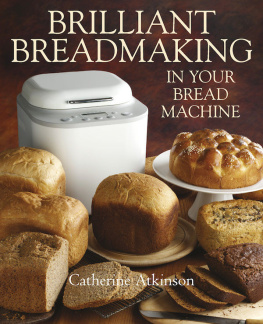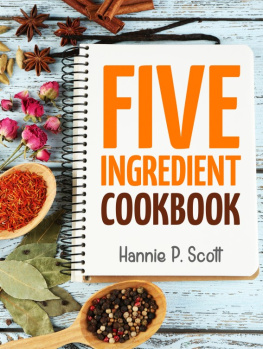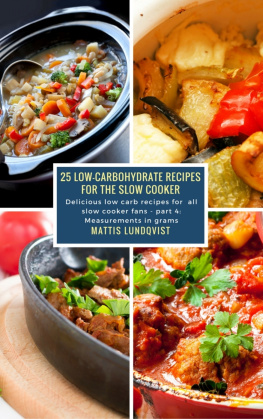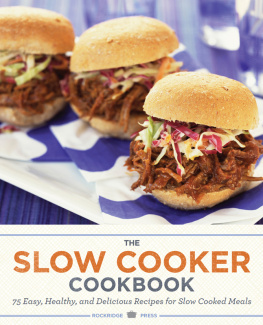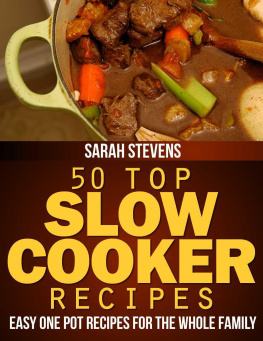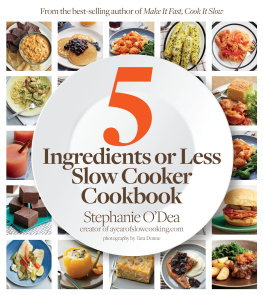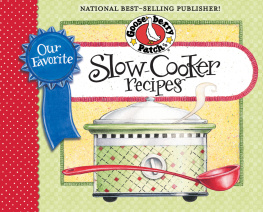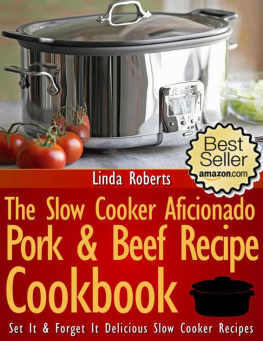Catherine Atkinson - The Classic Casseroles for Your Slow Cooker
Here you can read online Catherine Atkinson - The Classic Casseroles for Your Slow Cooker full text of the book (entire story) in english for free. Download pdf and epub, get meaning, cover and reviews about this ebook. year: 2011, publisher: W Foulsham & Co. Ltd, genre: Home and family. Description of the work, (preface) as well as reviews are available. Best literature library LitArk.com created for fans of good reading and offers a wide selection of genres:
Romance novel
Science fiction
Adventure
Detective
Science
History
Home and family
Prose
Art
Politics
Computer
Non-fiction
Religion
Business
Children
Humor
Choose a favorite category and find really read worthwhile books. Enjoy immersion in the world of imagination, feel the emotions of the characters or learn something new for yourself, make an fascinating discovery.
- Book:The Classic Casseroles for Your Slow Cooker
- Author:
- Publisher:W Foulsham & Co. Ltd
- Genre:
- Year:2011
- Rating:5 / 5
- Favourites:Add to favourites
- Your mark:
- 100
- 1
- 2
- 3
- 4
- 5
The Classic Casseroles for Your Slow Cooker: summary, description and annotation
We offer to read an annotation, description, summary or preface (depends on what the author of the book "The Classic Casseroles for Your Slow Cooker" wrote himself). If you haven't found the necessary information about the book — write in the comments, we will try to find it.
The slow cooker brings out the hidden depth of flavours. The sweetness of the vegetables is enhanced and the tenderness of the meats becomes remarkable. This is great eating - for every day, weekends or holidays. Just take your pick to suit your mood or the season - Simple Irish Stew - Coq au Vin - Easy Beef Stroganoff - Bouillabaisse - Sweet and Sour Pork - Chicken Gumbo - Lancashire Hot-pot - Boston Baked Beans. Fabulous food and great eating on every page.
Catherine Atkinson: author's other books
Who wrote The Classic Casseroles for Your Slow Cooker? Find out the surname, the name of the author of the book and a list of all author's works by series.
The Classic Casseroles for Your Slow Cooker — read online for free the complete book (whole text) full work
Below is the text of the book, divided by pages. System saving the place of the last page read, allows you to conveniently read the book "The Classic Casseroles for Your Slow Cooker" online for free, without having to search again every time where you left off. Put a bookmark, and you can go to the page where you finished reading at any time.
Font size:
Interval:
Bookmark:

Casseroles can be wonderfully varied, ranging from rich winter stews to satisfy robust appetites to more delicate mixtures that are ideal for lunches and light suppers. Because casseroles need minimal attention, they are perfect for simple family meals and also ideal for relaxed entertaining.
Casseroles, stews, carbonnades, hot-pots and navarins are all names for what is essentially the same type of dish meat and/or vegetables cooked in liquid in a cooking pot. Braises have a little less liquid and cook by a combination of simmering and steaming. Rags are especially rich casseroles. Originally, the word stew described dishes cooked on the stovetop, while casserole described dishes cooked in the oven, but now the names are largely interchangeable.
Slow cooking is the perfect way to create flavour-packed meals with the minimum effort and fuss. The basic principle is that food is cooked slowly at a low constant temperature. This has many advantages. One of the greatest is that it develops and enhances the flavour of food, while retaining its texture. It brings out the sweetness of vegetables and makes even the toughest meat meltingly tender; in fact, the less expensive cuts are better suited to slow cooking. Slow cookers are also environmentally friendly; their low wattage consumes about the same amount of electricity as a light bulb. A bonus is that food is unlikely to burn or over-dry.
If you're out for the day, an extra hour of cooking won't ruin your recipe, so there's no need to worry if you get home a little later than planned. Timing is rarely critical, so if you are not ready when the casserole is, it can be left on the Low setting to keep it warm.
The principles of slow cooking are incredibly simple, but do have a look at the following few pages before you begin.
Slow cookers now come in a huge range of colours, shapes, sizes and prices and these factors need to be considered before you make your choice.
Appearance is the first thing you'll notice. You'll find contemporary stainless steel, vibrant coloured and pristine white models as well as the rustic-looking cream and brown versions. The heat-resistant lid may be ceramic or toughened glass. The advantage of the latter is that you can monitor the food's progress without having to lift the lid and lose precious heat. Originally only round cookers were available; these are excellent for casserole making but the more modern oval version is a better buy if you entertain often as it's perfect for pot-roasting larger cuts of meat or want to casserole whole fish fillets.
The size of slow cookers ranges from a tiny 600 ml/1 pint/21/2 cup cooking pot to a massive 6.5 litre/111/4 pint/271/4 cup, so choose a size that suits your needs. These recipes mainly serve four, so a 4 litre/7 pint/16 cup in size is about right.
Because slow cooker models vary, make sure you read the manufacturer's instructions before using yours for the first time. Some slow cookers need to be preheated before you start cooking; others advise against heating the slow cooker when empty. You should also check to see whether yours is dishwasherproof and whether it can be used under the grill (broiler) and in the oven, in the microwave or the freezer.
Before using for the first time, wash the ceramic cooking pot in hot soapy water, rinse well and dry.You may notice a slight odour as the slow cooker heats up; this is caused by the burning off of manufacturing residues and should disappear after the first few uses. Don't worry if the ceramic glaze becomes slightly crazed; this is perfectly normal.
You'll notice that the recipes advise using hot, not boiling, water and stock when adding it straight to the cooking pot. Never pour boiling water into the cold cooking pot (you can do so when it is already warm or hot) or plunge it into cold water immediately after use as this could crack it. Remember that it is an electrical appliance, so the outer casing should be wiped clean and never immersed in or filled with water.
When following a recipe, bear in mind that every model is slightly different and, even when using the same settings, some will cook much faster than others. For this reason a range of cooking times is given; you may need to use the shorter or the longer time or somewhere between the two. After trying a few recipes, you will know whether your slow cooker is faster or slower and you will be able to adjust the recipe cooking times accordingly.
During cooking, steam condenses on the lid of the slow cooker, then trickles back into the pot, helping to retain heat and reduce strong cooking smells. Unless a recipe tells you to stir a dish part-way through cooking, it should be left undisturbed and you should avoid lifting the lid.
The slow cooker is an extremely safe appliance, but commonsense precautions should be followed. Although it cooks at a low temperature, the outer casing, lid and the food inside the slow cooker may get extremely hot, so you should always use oven gloves when removing the ceramic cooking pot. Stand the slow cooker on a heat-resistant surface when in use, away from the edge where it might accidentally get knocked off, and make sure that the mains lead is tucked safely behind it.Take extra care that it's out of reach if you have young children or inquisitive pets living or staying with you.
Slow cookers cook food at a relatively low heat around 90C/195F on the Low setting to about 150C/300F on the High setting. Any bacteria present in food is destroyed at 74C/165F, so as long as it's cooked for the correct time the temperature of the slow cooker will ensure that the food is safe to eat.You should take care, however, not to reduce the cooking temperature:
- Do not lift the lid during the cooking time unless the recipe specifies this.
- Ideally ingredients should be at room temperature when you start to cook. If you are using large amounts of frozen vegetables, it's a good idea to set the slow cooker on High or Auto for the first hour of cooking. Never add frozen or part-frozen meat to the slow cooker.
- You may need to increase the cooking time slightly when the kitchen temperature is extremely cold.
- Avoid placing the slow cooker in a draughty place or near an open window.
- Always check that meat is thoroughly cooked, particularly poultry and pork. A meat thermometer is a good investment if you cook portions or larger cuts of meat as it will ensure they are sufficiently cooked without drying out and losing moistness. The meat is ready when the pointer on the dial reaches the appropriate wording; there are indications for types of meat including chicken, beef, lamb and pork, as well as readings within some of those categories for rare, medium and well-cooked meat.
The cooking temperatures and settings vary on different models, but most have four settings: Off, Low, High and Auto. Some models have an additional Medium setting. At the lowest temperature the food will barely simmer; at the highest it will boil very gently.When set to Auto, the cooking temperature will build up to High, then remain at this temperature for an hour or so before automatically switching to Low. This setting is desirable if you are using frozen vegetables in your cooking without defrosting them first. Foods such as cuts of poultry, like chicken quarters and whole thighs (but not breasts or chopped chicken) should always be cooked on High or Auto for at least the first hour. Food should be monitored when using the High setting as some liquid will evaporate. Some flexibility can be introduced to the total cooking time by adjusting the temperature settings; for dishes such as soups, braises and casseroles, the cooking can be shortened or extended to suit your needs by changing the temperature setting. As a rough guide, the cooking time on Low is about double that of High.
Next pageFont size:
Interval:
Bookmark:
Similar books «The Classic Casseroles for Your Slow Cooker»
Look at similar books to The Classic Casseroles for Your Slow Cooker. We have selected literature similar in name and meaning in the hope of providing readers with more options to find new, interesting, not yet read works.
Discussion, reviews of the book The Classic Casseroles for Your Slow Cooker and just readers' own opinions. Leave your comments, write what you think about the work, its meaning or the main characters. Specify what exactly you liked and what you didn't like, and why you think so.

